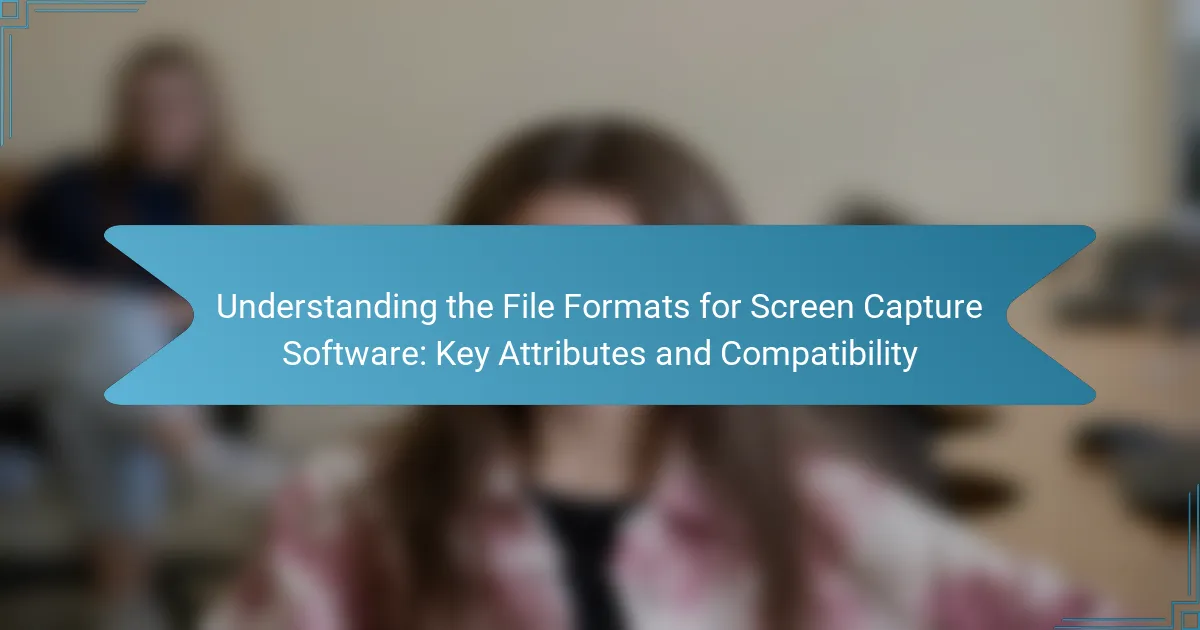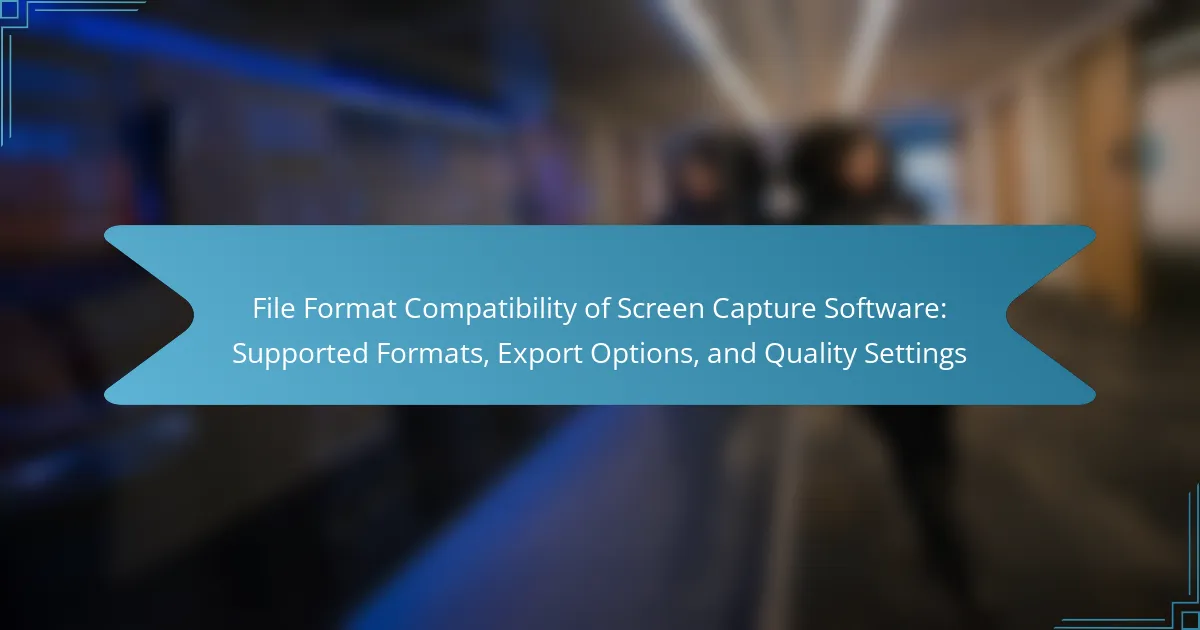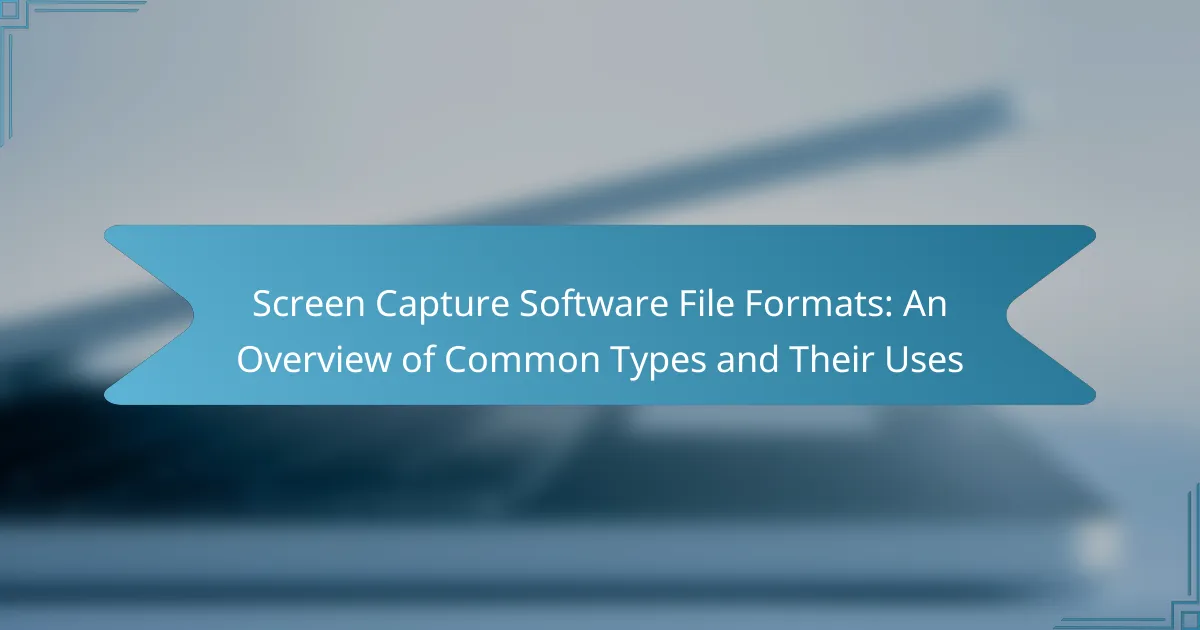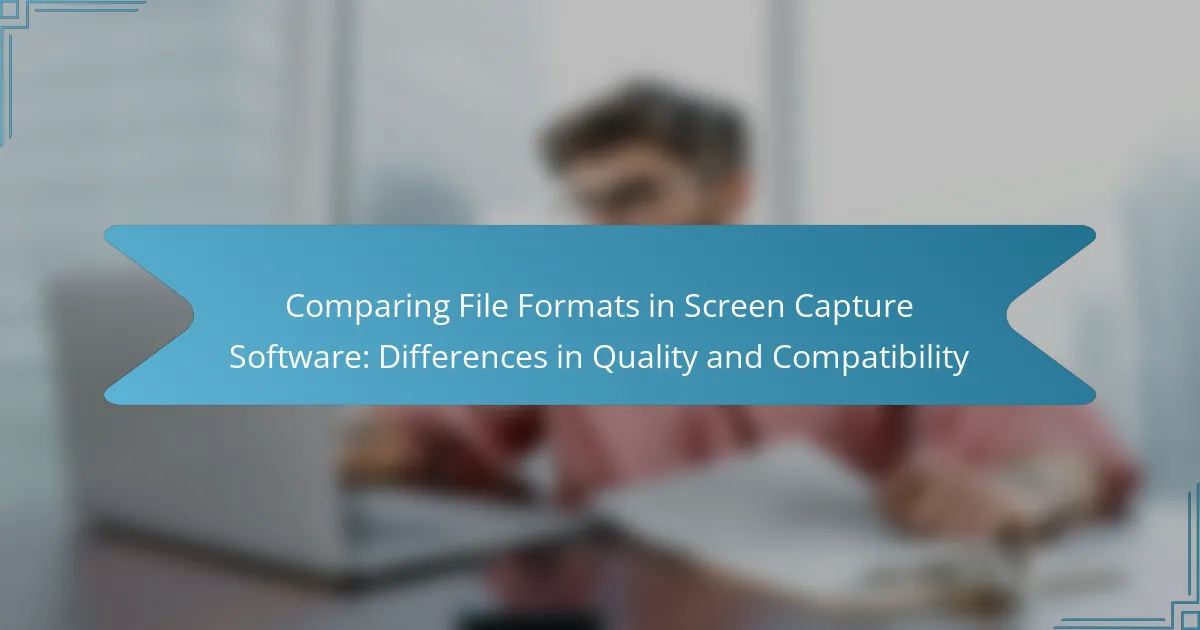Screen capture software utilizes various file formats to save images and videos, with the most common being PNG, JPEG, GIF, BMP, and MP4. Each format is characterized by specific attributes such as compression type, resolution, color depth, and compatibility, which influence their usability. PNG offers lossless compression and transparency, while JPEG provides smaller file sizes at the cost of some quality. GIF supports simple animations but is limited in color depth, BMP maintains high quality without compression, and MP4 is the standard for video captures. Understanding these formats and their compatibility considerations is crucial for effective storage, sharing, and editing of screen capture files.
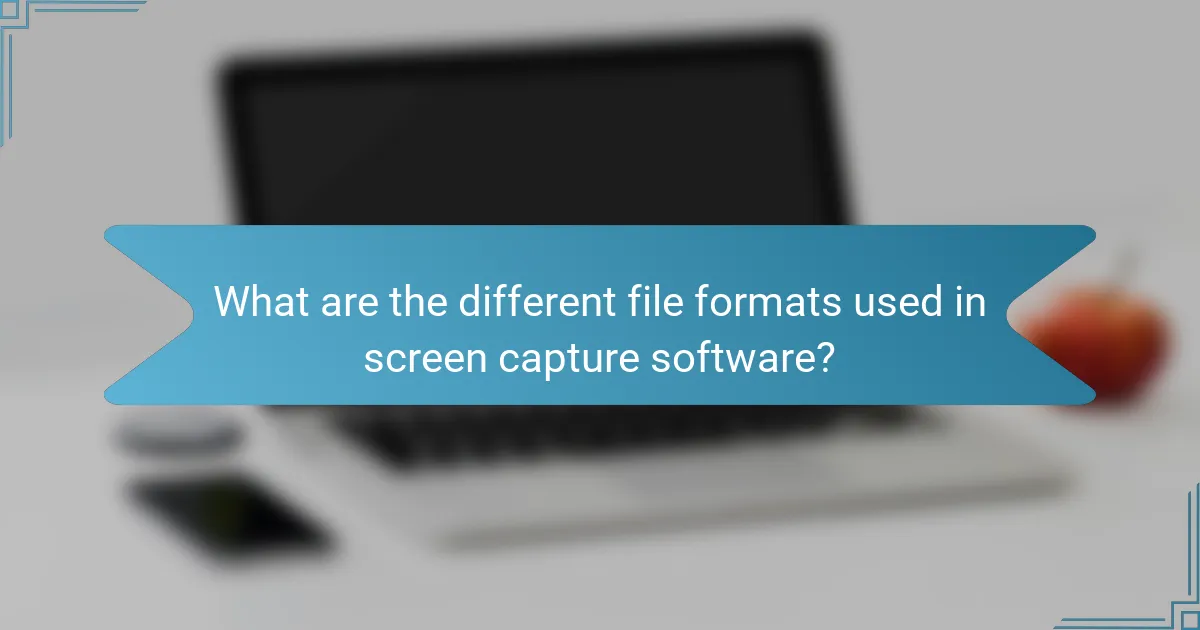
What are the different file formats used in screen capture software?
Screen capture software commonly uses various file formats for saving images and videos. The most prevalent formats include PNG, JPEG, GIF, BMP, and MP4. PNG is favored for its lossless compression and transparency support. JPEG is widely used for photos due to its smaller file size, although it loses some quality. GIF is popular for simple animations but is limited to 256 colors. BMP is an uncompressed format that retains high quality but results in larger file sizes. MP4 is the standard for video captures, providing efficient compression and broad compatibility with devices. Each format serves specific needs based on quality, size, and functionality.
How do these file formats differ from one another?
File formats for screen capture software differ primarily in their compression methods, quality, and compatibility. For instance, PNG is lossless, preserving image quality, while JPEG uses lossy compression, reducing file size at the cost of quality. BMP files are uncompressed, offering high quality but large file sizes. GIF supports animation but limits color depth. Each format serves different needs, such as PNG for high-quality images and JPEG for web use. Compatibility varies; for example, PNG and JPEG are widely supported across platforms, while BMP may not be as universally accepted. Understanding these differences helps users select the appropriate format for their needs.
What are the common characteristics of popular screen capture file formats?
Popular screen capture file formats share several common characteristics. They typically support lossless or lossy compression methods. Lossless formats like PNG retain original image quality. Lossy formats such as JPEG reduce file size at the expense of some quality. Most formats offer a balance between image quality and file size. They also support various color depths, commonly 24-bit or 32-bit. Screen capture formats are often compatible with multiple operating systems and software applications. Additionally, they may include metadata for additional context. These characteristics ensure usability across different platforms and applications.
How does file format choice impact image quality and file size?
File format choice significantly impacts image quality and file size. Different file formats use varying compression methods. Lossy formats like JPEG reduce file size but sacrifice some image quality. Lossless formats like PNG maintain image quality but result in larger file sizes. For example, a JPEG image can be 10 times smaller than a PNG of the same resolution. The choice of format should align with the intended use of the image. High-quality prints require lossless formats, while web images benefit from smaller, lossy formats. Thus, selecting the appropriate file format is crucial for balancing quality and size.
Why is understanding file formats important for screen capture software users?
Understanding file formats is crucial for screen capture software users because it affects compatibility and usability. Different file formats have specific attributes that determine their quality, size, and application. For instance, formats like PNG offer lossless compression, preserving image quality. In contrast, JPEG uses lossy compression, which can reduce quality but results in smaller file sizes. Users must choose the appropriate format based on their needs, such as editing or sharing. Additionally, some software may not support certain file formats, leading to accessibility issues. Understanding these differences ensures users can effectively utilize their captured content across various platforms and applications.
What role do file formats play in compatibility with various platforms?
File formats determine how data is structured and stored, influencing compatibility across platforms. Different operating systems and software applications support specific file formats. For example, JPEG and PNG formats are widely accepted for images across most devices. Conversely, some proprietary formats may only function within specific software. Compatibility issues can arise when a platform does not recognize a file format, leading to errors or inability to open files. Thus, choosing the right file format is crucial for ensuring seamless data exchange and usability across various platforms.
How can file formats affect editing and sharing options?
File formats significantly affect editing and sharing options. Different formats support varying levels of compression, quality, and compatibility. For example, formats like PNG and TIFF maintain high quality but result in larger file sizes. This can limit sharing capabilities over platforms with size restrictions. Conversely, formats like JPEG compress images, making them easier to share but at the cost of some quality. Editing capabilities also differ; some formats, such as PSD, retain layers and adjustments, allowing for extensive editing. Others, like GIF, support limited editing options due to their simpler structure. Therefore, choosing the right file format is crucial for both the desired editing flexibility and sharing efficiency.
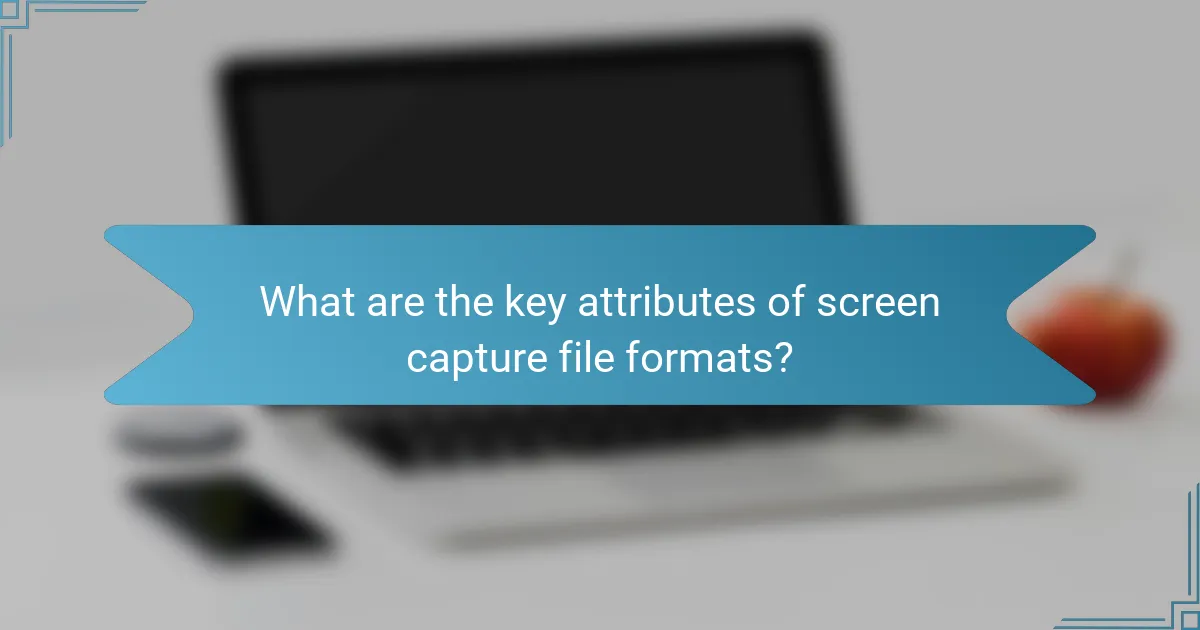
What are the key attributes of screen capture file formats?
Key attributes of screen capture file formats include compression, resolution, color depth, and compatibility. Compression determines the file size and quality, affecting storage and sharing. Common formats like PNG use lossless compression, while JPEG employs lossy compression. Resolution indicates the pixel dimensions, influencing clarity and detail. Higher resolutions provide better quality, suitable for professional use. Color depth defines the number of colors in the image, impacting visual fidelity. Formats like BMP support high color depth, while GIF is limited to 256 colors. Compatibility refers to software and hardware support for file formats. Popular formats like MP4 and AVI are widely supported across platforms. These attributes collectively influence the usability and effectiveness of screen capture files.
What are the benefits of using different file formats in screen capture?
Using different file formats in screen capture offers various benefits. Each format serves specific purposes based on quality, size, and compatibility. For instance, PNG files provide lossless compression, ensuring high-quality images. JPEG files, on the other hand, offer smaller file sizes due to lossy compression, making them suitable for web use. GIF files support animation, allowing for dynamic content capture. BMP files retain the original quality but result in larger sizes, ideal for professional use. Different formats enhance usability across platforms and applications, ensuring wider accessibility. Choosing the right format can optimize storage and performance based on user needs.
How do resolution and compression relate to file format attributes?
Resolution and compression are key attributes that influence file format characteristics. Resolution refers to the detail an image holds, typically measured in pixels. Higher resolution results in clearer images, but increases file size. Compression reduces file size by removing some data. Lossy compression sacrifices some image quality for smaller file sizes. Lossless compression maintains image quality but achieves less size reduction. Different file formats utilize these attributes uniquely. For example, PNG supports lossless compression, preserving resolution. JPEG uses lossy compression, allowing significant size reduction at the cost of some detail. Understanding these relationships helps users choose appropriate file formats for specific needs.
What are the implications of using lossless versus lossy formats?
Lossless formats preserve the original quality of data, while lossy formats reduce file size by sacrificing some quality. Using lossless formats is essential for applications requiring high fidelity, such as professional video editing or archiving. In contrast, lossy formats are suitable for web usage or streaming, where smaller file sizes enhance loading speeds. Lossless formats typically result in larger file sizes, which can consume more storage space and bandwidth. Lossy formats, however, are more efficient for everyday use, allowing for quicker uploads and downloads. The choice between these formats impacts the balance between quality and storage efficiency. For example, PNG is a lossless format, while JPEG is a common lossy format.
How do file formats impact the performance of screen capture software?
File formats significantly impact the performance of screen capture software. Different formats affect the quality, size, and speed of the captured files. For instance, formats like PNG offer lossless compression, preserving image quality but resulting in larger file sizes. Conversely, JPEG uses lossy compression, reducing file sizes at the cost of some quality.
The choice of file format can also influence processing speed. Formats that compress data more efficiently can lead to faster saving and sharing times. Moreover, compatibility with various platforms and software can affect usability. Some formats are universally accepted, while others may require specific software to view or edit.
According to a study by Adobe, the choice of file format can reduce file size by up to 90% without significant quality loss in certain scenarios. This demonstrates the crucial role of file formats in optimizing screen capture performance.
What factors should be considered when selecting a file format for screen capture?
When selecting a file format for screen capture, consider compatibility, quality, and file size. Compatibility ensures that the format works with your intended software and devices. Common formats like PNG and JPEG are widely supported across platforms. Quality is vital for clarity; lossless formats like PNG preserve detail. File size impacts storage and sharing; formats like JPEG offer smaller sizes at the cost of some quality. Additionally, consider the purpose of the capture; for editing, higher-quality formats are preferable.
How do user preferences influence file format selection?
User preferences significantly influence file format selection. Users choose formats based on compatibility with software and devices. For instance, JPEG is favored for images due to its widespread support. Users may prefer PNG for screenshots because it preserves transparency. File size also matters; users often select formats that balance quality and storage efficiency. Additionally, specific use cases drive choices, such as GIF for animations. Preferences are shaped by familiarity and ease of use. Research shows that user experience impacts format selection decisions directly.
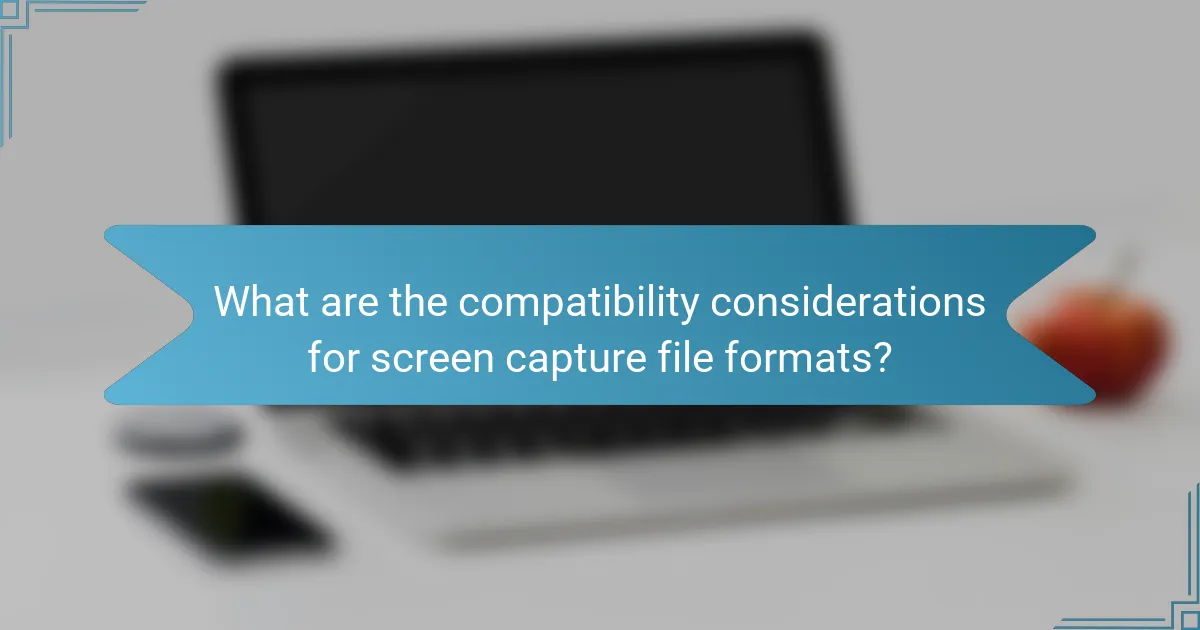
What are the compatibility considerations for screen capture file formats?
Compatibility considerations for screen capture file formats include software support, file size, and quality. Different applications may only support specific formats like MP4, AVI, or GIF. File size affects storage and sharing capabilities. High-quality formats may require more storage space, impacting compatibility with devices with limited capacity. Additionally, some formats may not maintain quality during compression, affecting playback. It’s essential to choose a format compatible with the intended use, whether for editing, sharing, or archiving. Compatibility also varies across operating systems, influencing the choice of file format for cross-platform use.
How do different operating systems handle screen capture file formats?
Different operating systems handle screen capture file formats in distinct ways. Windows primarily uses PNG and BMP formats for screen captures. macOS utilizes PNG and TIFF formats, often favoring the former for its balance of quality and file size. Linux supports a variety of formats, including PNG, JPEG, and GIF, depending on the desktop environment and tools used.
Windows allows users to save captures directly to the clipboard or as files. macOS provides the option to save captures to the desktop or clipboard with specific keyboard shortcuts. Linux tools like Flameshot and Shutter offer customizable saving options for various formats.
File format compatibility may vary between systems. For instance, PNG is widely supported across all operating systems. JPEG is also common but may lose quality during compression. TIFF, while high-quality, is less commonly used outside of professional environments.
These differences reflect the design philosophies and user needs of each operating system. Understanding these variations helps users choose the right tools for their screen capture needs.
What are the common compatibility issues users might face?
Common compatibility issues users might face include unsupported file formats, software version mismatches, and operating system incompatibilities. Unsupported file formats occur when the screen capture software cannot read or export certain file types. Software version mismatches happen when different versions of screen capture software do not work seamlessly together. Operating system incompatibilities arise when the software is not designed for the user’s specific OS, leading to functionality issues. These problems can hinder the user experience and limit the effectiveness of screen capture tools.
How can users ensure their screen captures are accessible across devices?
Users can ensure their screen captures are accessible across devices by selecting compatible file formats. Common formats like PNG, JPEG, and GIF are widely supported across various platforms. Saving screen captures in these formats enhances their accessibility. Users should also consider resolution and file size for optimal performance. High-resolution images may not load efficiently on all devices. Using cloud storage services can facilitate easy sharing and access. These services often support multiple file formats and provide cross-device compatibility. Regularly updating software can also help maintain compatibility with evolving formats.
What best practices should users follow when choosing file formats for screen captures?
Users should choose file formats for screen captures based on their intended use and compatibility. PNG is ideal for high-quality images with transparency. JPEG is suitable for photographs where file size is a concern. GIF works well for simple animations and low-color images. BMP offers uncompressed quality but results in large file sizes. Users should also consider software compatibility; some programs may not support all formats. Additionally, think about the need for editing; formats like PNG retain quality better than JPEG when edited. Lastly, check the sharing platform’s requirements; some platforms may have preferred formats for optimal display.
How can users optimize file formats for specific use cases?
Users can optimize file formats by selecting the appropriate type for their specific needs. For example, PNG is ideal for images requiring transparency, while JPEG is better for photographs due to its smaller file size. Users should consider the balance between quality and file size. Lossless formats like TIFF maintain high quality but result in larger files. Conversely, lossy formats like MP4 reduce size at the expense of some quality. Additionally, users should assess the intended platform. Certain platforms may have preferred formats for compatibility. For instance, GIF is suitable for animations on social media, while PDF is preferred for documents. Understanding these attributes helps users choose the best format for their use case.
What troubleshooting tips can help resolve file format-related issues?
To resolve file format-related issues, first verify the file extension. Ensure it matches the expected format for the software being used. Next, check for software updates. Outdated software may not support newer file formats. Additionally, confirm that the file is not corrupted. Corruption can prevent proper opening and editing. If issues persist, try converting the file to a different format. Use reliable conversion tools for best results. Lastly, consult the software’s documentation for specific format compatibility. This can provide insights into supported formats and troubleshooting steps.
The main entity of this article is screen capture software and its associated file formats. The article provides a comprehensive overview of various file formats used in screen capture, including PNG, JPEG, GIF, BMP, and MP4, highlighting their unique attributes, compression methods, and compatibility. It discusses how these formats differ in terms of quality, file size, and usability, as well as the implications of choosing lossless versus lossy formats. Additionally, the article covers the importance of understanding file formats for effective editing, sharing, and cross-platform compatibility, along with best practices for selecting the appropriate format based on user needs.
